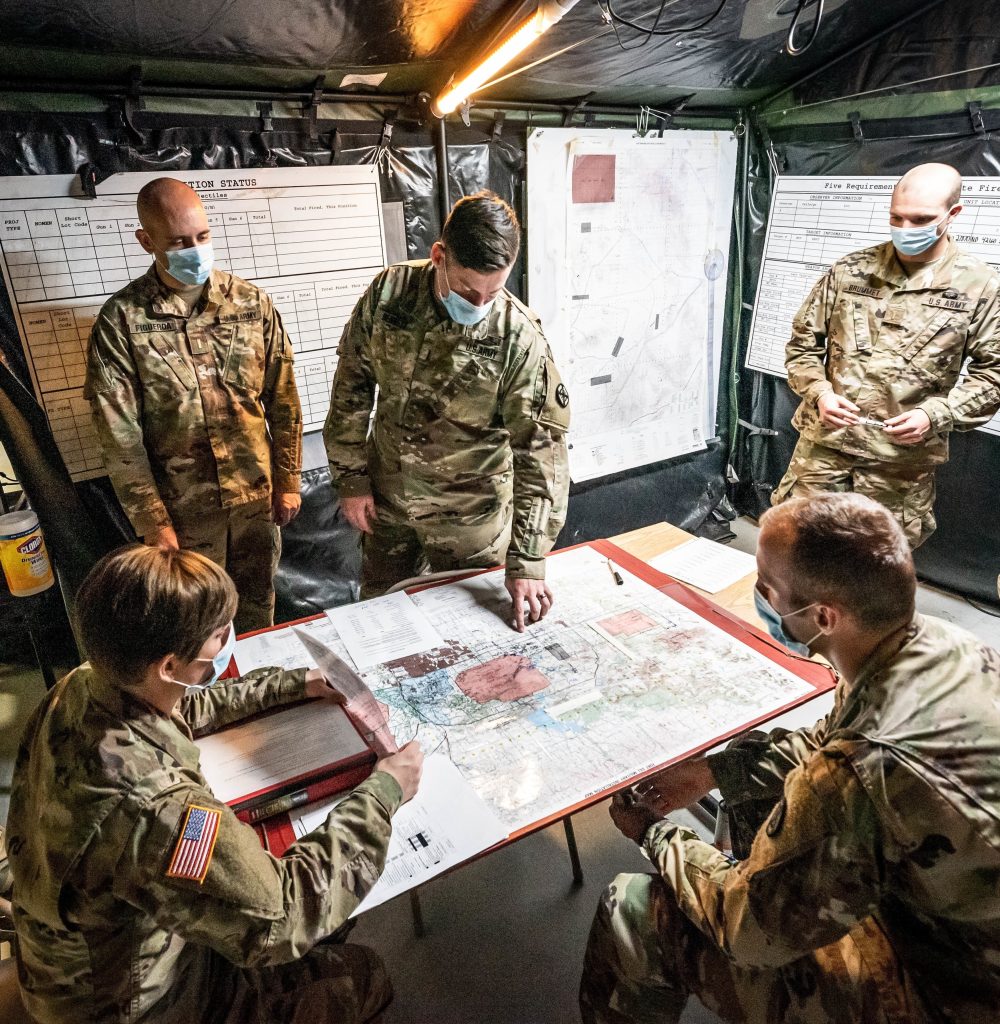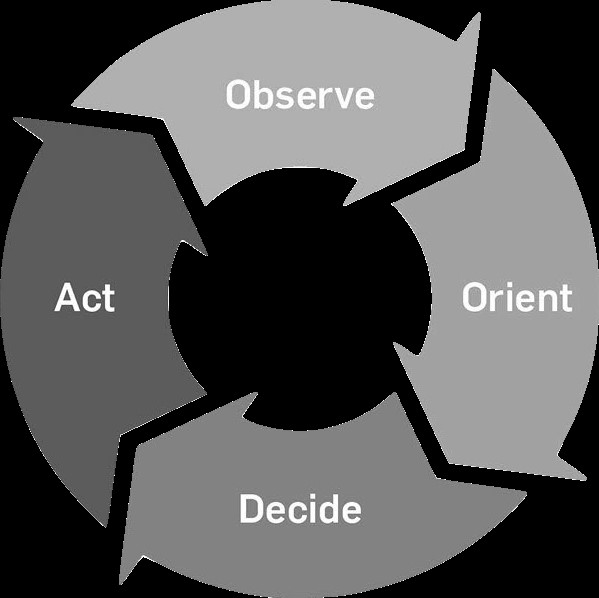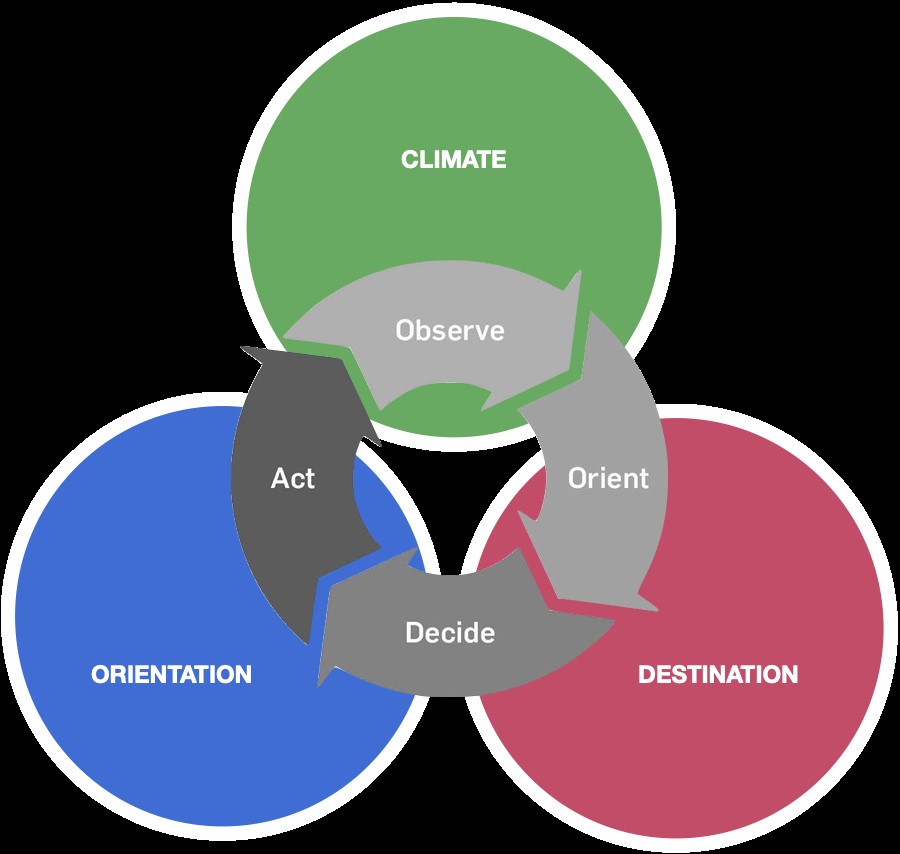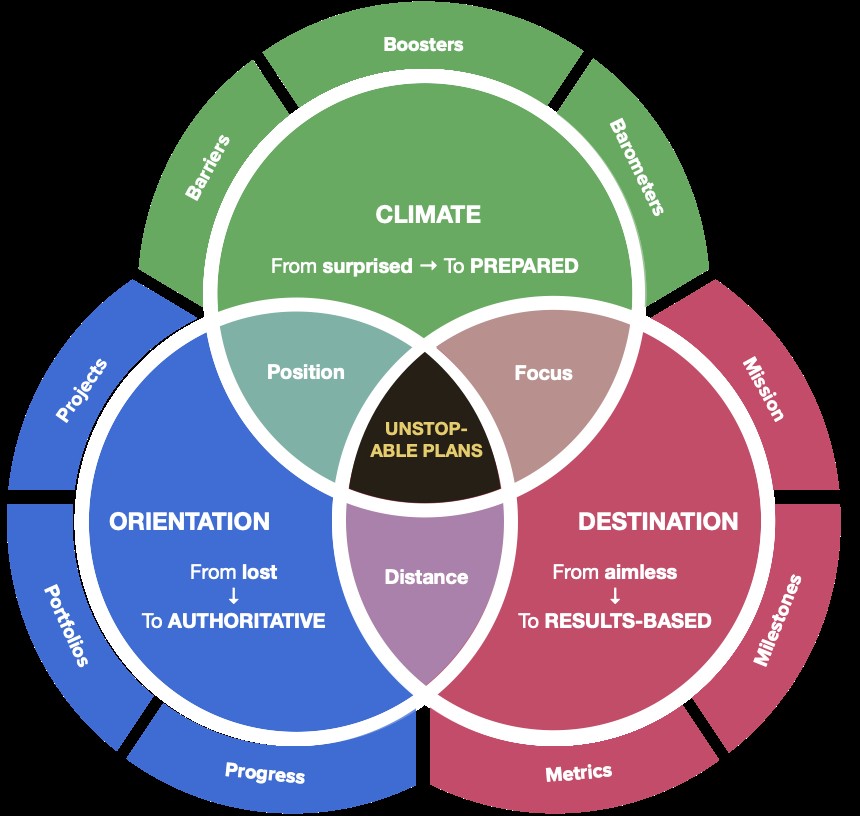
PLAN OF ACTION: Decision dominance enables combatant commanders to take decisive advantage in any situation. (Photo by Sgt. David Vermilyea, U.S. Army European Command)
How to create first-contact-proof plans that are resilient in the face of opposition.
Editor’s note: This is the second article by the authors on decision dominance. “Decision Dominance” appeared in the Spring edition.
by Richard A. Nabors, D.M., Jacqueline A. Randall and Nathan Burkholder
Not long ago, people exclusively used paper maps to navigate. Many of us can remember at some point having a Rand McNally map tucked behind or under our seat in the car and pulling it out across the dash or steering wheel while on a trip. Most of us haven’t used a paper map to navigate for many years. The problem with paper maps is threefold: they don’t immediately tell you where you are on the map, they don’t plot a course to your destination and they don’t update based on changes in the environment. Paper maps are not interactive and don’t avoid possible pitfalls and identify alternate routes when travel changes happen that affect you.
Several years ago, Waze, Google Maps and other apps popularized interactive navigation applications for smartphones, providing a solution to this problem by offering interactive navigation capabilities. By using real-time data from smartphone users, these tools help drivers find different routes to get to their destinations, avoiding traffic jams, crashes and even police cars that are on the lookout for speeders.
In many ways, these tools are an excellent example of how access to real-time sensor and communication data allows drivers to make better informed and more rapid decisions as travel conditions change moment to moment. As environments change, these interactive navigation tools help drivers proactively avoid issues and stay one step ahead of their opponents, be it other drivers or even traffic enforcement. Before these tools, if you missed a milestone, you might not find out until you had driven 10 minutes in the wrong direction. You would have to stop, pull over and make a new plan. If there was an accident or construction, you wouldn’t know and would find yourself stopped dead in traffic. If you were competing in a challenge such as “The Amazing Race,” having a navigation capability currently found on our smart phones would give you a significant advantage over your competition using paper maps.
In the U.S. military, there is another word for the same concept: decision dominance. Decision superiority is not new. It’s a simple notion: the side that makes quicker decisions will be more likely to prevail.
The implications of this doctrine, however, are anything but simple. It led to a sophisticated and complex theory for how militaries should organize themselves to make the best decisions about what information they need, when they need it, where it needs to be sent and who is qualified to receive it and act on it.

DEVELOPING THE STRATEGY: Achieving decision dominance is understanding what it takes for your opponent to surrender or not fight at all. This helps in developing a platform and strategy for countering adversaries. (Photo by Sgt. Amanda Hunt, U.S. Army Training and Doctrine Command Center of Excellence)
HISTORY OF DECISION DOMINANCE
As an idea, decision dominance has been around since before the Roman Empire. Decision dominance generates superior decision-making through increased understanding of one’s enemy and environment. It also represents using military capabilities as part of a holistic approach to shaping the opposition. Currently, decision dominance in action includes providing augmented reality information directly into the heads-up display of a warfighter, allowing the warfighter to know where they are in relation to a target immediately. The sensors that inform augmented reality capabilities improve a Soldiers ability to discern a friend from an adversary at safe distances. This real-time situational understanding of the battlespace allows the warfighter to make quicker, well-formed decisions faster than an adversary.
With advancements in technology and the exponential increase in data, the definition of decision dominance has evolved to include the ability to make decisions at every level of a military operation. For example, it is not enough for a Washington, D.C.-based commander to know what troops on the ground need; they must also have all the information they need to respond within seconds or minutes.
In the mid-20th century, Air Force Col. John Boyd developed a famous decision-making process known as the OODA loop to help fighter jet pilots make prompt and accurate decisions. OODA stands for observation, orientation, decision and action. See Figure 1. It is a continuous cycle of information gathering and decision-making that must be executed quickly with minimal friction or confusion to achieve success. The side that is able to have the fastest possible time between their OODA loop decision cycles will generate significant advantages for itself in achieving dominance over their adversaries. This begs the question, how can the decision loop cycle be reduced and optimized?

Weeks before the 2003 Iraq War, former U.S. Air Force Lt. Col. Merrick E. Krause wrote one of the first articles on decision dominance for Defense Horizons, a National Defense University publication. Titled “Decision Dominance: Exploiting Transformational Asymmetries,” the article explained that decision dominance was increasingly significant because the nature of war was changing in the 21st century.
“Decision dominance is now possible by exploiting technology and innovation to achieve long-term success through affordable and precise effects-based planning. This concept is a departure from the traditional Napoleonic war-fighting philosophies of attrition or annihilation,” Krause wrote.
Early lst year, Gen. James McConville, the Army chief of staff, published a report titled “Army Multi-Domain Transformation: Ready to Win in Competition and Conflict.” The unclassified version of the report explained that sensor data, communications and artificial intelligence were vital to achieving decision dominance in today’s world.
“Artificial intelligence, autonomy and robotics will continue to change the character of operational campaigns, resulting in a battlefield that is faster, more lethal, and distributed,” the report said.
“Decision dominance is enabled by convergence, the ability to see, sense, communicate, shoot, and move at speed and scale, connecting all sensors with the best shooter and the right C2 [command and control] node,” the report added.
To achieve decision dominance, the U.S. Army maintains a center called C5ISR (Command, Control, Communications, Computers, Cyber, Intelligence, Surveillance and Reconnaissance). The center’s core objective is to deliver technologies and capabilities that make it easier for tactical and strategic decision-makers to act decisively and execute their missions with great accuracy, efficiency and effectiveness.

VIRTUAL VIGILENCE: Currently, decision dominance in action includes providing augmented reality information directly into the heads-up display of a warfighter, enabling the warfighter to know where they are in relation to a target immediately. (Photo by Edric Thompson, U.S. Army C5ISR Center)
UNSTOPPABLE PLANS
Through decision dominance it is possible and advantageous to develop and sustain unstoppable plans that allow tactical and strategic leaders to remain resilient in the face of opposition. Unstoppable plans are devised proactively, keeping yourself one step ahead of the adversary and shaping the environment to limit and direct what options your opponent has available. Unstoppable plans are not limited to any specific domain such as air, sea or land. Achieving decision dominance in one area of operation often affects other domains since it’s virtually impossible to create an unstoppable plan without considering all aspects of combat.
While Boyd’s OODA loop—developed more than half a century ago—remains relevant today, to achieve decision dominance requires an additional model (or plan) that incorporates the time needed to support the processes for faster decision cycles. Broadly, the approach depends on the convergence of three intersecting circles: climate, orientation and destination. Said another way, to have an unstoppable plan, you need to be able to know your current orientation while reacting to an evolving climate so that you can reach your destination in time to be effective. See Figure 2.

These elements of orientation, climate and destination are not only true for navigation (such as with the navigation apps) they are also true at both the tactical and strategic level. Transformational technologies are those technologies that help bring each of these circles close together by reducing the time and effort required for the OODA process to take place. For the tactical user this could be something like an integrated sensor architecture that enables units on the ground to be able to integrate real-time intelligence data with their immediate environment via a heads up display, all while being directed through an urban environment by an artificial intelligence algorithm designed to minimize human contact with civilians. For an acquisition leader, this could be real-time portfolio investment optimization based on evolving third-party trend reports and published industry investment roadmaps.
Many organizations and individuals have one or more of these circles in place but the process of communicating, networking and integrating between them is fractured, static, laborious and costly. Transformational technologies bridge the gap between and pull the circles closer together until they overlap. And when all three circles intersect, unstoppable plans are possible.

KNOW THY ENEMY: Through knowledge of the opponent’s decision-making process, combatant commanders can react to their enemy with speed and precision, maneuvering them out of advantageous positions or bringing them under attack from multiple directions at once. (Photo by William B. King, U.S. Army)
|
Orientation How to move away from feeling lost to being authoritative? Whether it’s knowing how much ammunition, water or fuel you have left or knowing about long-term portfolio investments, orientation is all about figuring out and characterizing your current state and understanding how all the pieces fit together in a structured framework. For example, recently many within the Pentagon have seen the value in moving away from platform-focused investments and strategic planning towards an integrated portfolio approach. Climate It’s been said, “No plan survives first contact with the enemy.” How to move from surprised to being prepared? A changing climate affects acquisition, strategy, and execution. The ability to identify and react to the barriers, boosters and barometers affecting your plan allows you to not only survive first contact but to remain dominant over time. Destination How to move from aimless to results-based? If you don’t know your mission, milestones and metrics you can’t have an unstoppable plan. Recent publications such as Christian Brose’s “The Kill Chain: Defending America in the Future of High-Tech Warfare” points out how the emergence of new technologies and the growing military threat posed by rivals, such as China, have placed America at grave risk of losing a future war. Without a holistic destination in mind, investments and military planning become aimless and chaotic. By mapping the missions, metric and milestone decisions become results-based rather than personality-based, and greater opportunities can emerge. See Figure 3. |

FROM WAR OF ATTRITION TO WAR OF DECISION
As Krause explained in his 2003 article, the goal of decision dominance is not to destroy the enemy, but to make them surrender or not fight you in the first place. It’s about moving past attrition warfare, where two parties keep killing each other until one side quits. Decision dominance is about making the enemy decide to quit before they even start fighting you.
The first step in achieving decision dominance is understanding what it takes for your opponent to surrender or not fight at all. This will help you develop a platform and strategy for countering your adversary. The second step is to develop a plan that can handle anything the enemy throws at you and be able to adjust in real time as needed.
Thus, decision dominance relies on having accurate knowledge of what drives your opponent’s decisions, which allows you to be able to counter their moves before they make them. This requires more than just understanding their culture and geography. It’s about understanding how they think, what their fears are and what motivates them.
Decision dominance is achieved when you have the right people to execute the plan with accurate knowledge of your opponent’s decision-making process and the ability to decide faster than your opponent on what actions to take. The most important aspect of decision dominance is to understand what your opponent’s strategy and intentions are, so you don’t fall into their traps or get caught off guard by an unexpected attack.
It is through the knowledge of the opponent’s decision-making process that combatant commanders can react to their enemy with speed and precision, maneuvering them out of advantageous positions or bringing them under attack from multiple directions at once. Decision dominance enables combatant commanders to take decisive advantage in any situation.
“It is increasingly critical to move toward a strategy that does not rely on attrition or annihilation and that affects the mechanisms permitting the enemy to be defeated economically,” wrote Krause.
“Deliberate and methodical application of this decision dominance strategy will promote the goal of full-spectrum dominance by shaping and dominating an adversary’s decision-making cycle and understanding how, when and why the enemy leader will realize defeat.”

NO LIMITS: Unstoppable plans are not limited to any specific domain such as air, sea or land. (Photo by Sgt. Paige Behringer, U.S. Army)
CONCLUSION
In this new paradigm we see how decision dominance has become a highly desirable end state that provides both tactical and strategic planners with a spectrum of tools and options for mitigating threats. In some instances, this can be done without the need for violence or kinetic effects. Decision dominance is achieved with the ability to create unstoppable plans that adapt to a changing environment and fully integrate your current state with your objective outcomes. This adaptability, the ability to spring back to a steady state after dealing with a crisis (decision point), is what gives power and advantage to one side over another and will be one of the critical factors affecting the future conflicts that the U.S. and other countries face.
Transformational technologies that link and connect between platforms, intelligence and missions will play a key role in making resilience possible by shortening the OODA loop decision cycles that shape the tactical, strategic and acquisition landscapes. And just like Waze, this will allow the U.S. military to always keep moving, to never be stopped, to adjust and become unstoppable.
For more information on the C5ISR Center and its mission, visit https://c5isr.ccdc.army.mil/.
RICHARD A. NABORS, D.M., is the principal deputy director of the DEVCOM C5ISR Center’s Research and Technology Integration Directorate. He holds a doctor of management from the University of Phoenix, an M.S. in management from the Florida Institute of Technology and a B.A. in history from Old Dominion University. He is Level I certified in program management.
JACQUELINE A. RANDALL is a DOD contractor with AnaVation, LLC. supporting the C5ISR Research and Technology Integration (RTI) Directorate. She holds a B.A. in psychology from Siena College. She is a certified associate in project management.
NATHAN BURKHOLDER is a strategic analyst for KITEWIRE Inc. who supports C5ISR RTI. He holds a B.S. in engineering from Messiah College.
Read the full article in the Summer 2022 issue of Army AL&T magazine.
Subscribe to Army AL&T – the premier source of Army acquisition news and information.


